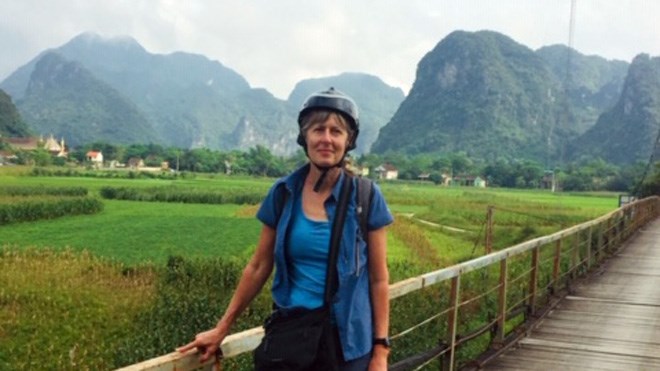By Suzanne Harvey
Travelling in Phong Nha-Ke Bang National Park, Vietnam
“By the way,” advised our guide as we plunged into the rushing underground river, “there are eels.”
I have travelled to Phong Nha-Ke Bang National Park for the caves. Home to Asia’s oldest karst mountains, Phong Nha is located roughly 55 km inland at Vietnam’s narrowest point (near the Laos-Vietnam border).
The park leapt to world attention when, in 2009, a local farmer rediscovered the world’s largest cave (he first discovered it years earlier but in the dense jungle could not find his way back). Massive Hang Son Doong (Son Doong Cave) is believed to have twice the cross-sectional size as the world’s second biggest cave. In fact, Phong Nha is laced with rambling cave systems and swift-flowing underground rivers.
Getting to Phong Nha Park is easy on any of several daily buses from the cities of Hue, Hoi An, or Dong Hoi. En route, you pass through the former Demilitarized Zone (DMZ) of the Vietnam War (known here as the American War) and see a replica of Hien Luong footbridge (the original was destroyed in 1967) painted half yellow and half blue to represent the once separate North and South Vietnam.
Sections of the famous Ho Chi Minh Trail (the North Vietnamese army’s treacherous supply route) loop though this area and still-hidden land mines prevent independent trekking. Before you arrive in Phong Nha, the emerald beauty of neatly tended rice paddies and the rugged, jungle-shrouded shapes of the karst mountains lure you in.
I booked a day tour with Oxalis, a world-class company specializing in caving adventures (also the only company licensed to guide limited tours into Son Doong Cave). Our van descends hair-pin curves deep into the countryside to the home of the Tu Lan cave system (recently famous as one location of the “Kong: Skull Island” movie shoot).
One of the many bonuses of travelling is that you meet fellow wanderers from all over the planet.
This day our group includes Ho (our attentive and cheerful guide), an American couple, and three other solo travelers: from France, Reunion Island and Germany respectively.
Our start coincides with the start of the annual Oxalis fundraiser, a gruelling three-day timed competition where staff teams paddle and run to raise money for local education and housing. Fluorescent-clad teams whoop passed us as we skirt rice paddies and nonchalant water buffalo, and disappear into the jungle.
One hour and two river crossings later, we reach Rat Cave, so named because the stalactites at the entrance resemble rats teeth (Phew! No actual rodents). We scramble up through the jagged opening just as two Vietnamese women materialize from the pitch-black interior. Rat Cave, it turns out, has a small rear entrance and locals use the cavern as a shortcut between two adjacent valleys. We don helmets, headlamps and gloves, and spend 40 minutes climbing and crawling through the cave’s nether regions.
Outside again, the mid-day blast furnace heat scorches us as we hike to Tu Lan Cave and scramble through the small entrance. The darkness is immediate and complete. Head lamps set to high-beam reveal long-limbed spiders clinging to limestone formations. We hike quietly, speaking softly, feeling that anything above a whisper may destroy an ancient silence. This is my first “natural cave”, without lighting and boardwalks, and I am surprised by an absence of fear and the presence of wonder.
During the rainy season, water floods these chambers making visits impossible. Today, the silt-clouded river flows swift and calm. Which brings us back to the eels. I try not to think about them as we swim the final 100 metres toward the exit, clamber onto the rocks by the lip of a waterfall and follow Ho into a tranquil jungle pool.
For the next hour we swim and eat fresh local food, serenaded by an orchestra of cicadas and surrounded by clouds of butterflies. On our return journey we swim a longer route, enjoying the cool water and the light play of our headlamps on the limestone formations.
Our arrival back at the van coincides with the first Oxalis team completing the event. We high-five them as they run/plod toward the finish. The water buffalo remain nonchalant. A woman, sporting a traditional woven conical hat ambles by, her shoulder-baskets laden with long grasses.
I look around and it is perfect.
Someday, I hope to return to Phong Nha-Ke Bang and undertake a longer cave journey. Various companies offer muti-day camping adventures.
I ask Ho, “What is your favourite cave?”
“Son Doong,” he replies, his face creased by a huge smile. “I am guiding there tomorrow.”
I can’t but feel just a little bit jealous.
Suzanne Harvey is currently travelling solo for 14 weeks through Asia and Europe and blogging about her adventures at OneDustyBackpack.com. Periodically, Sudbury.com will bring you dispatches about her exploits.
